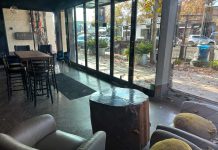GILROY
– Following the advice of its consultant and a community task
force, the City Council signed off Monday on a conceptual site and
design for a new arts and cultural center at the southern end of
Gilroy’s downtown core.
But the 6-1 vote to approve the site at Monterey, Eigleberry and
Seventh streets did not come without debate, including a bit of
sniping between Mayor Tom Springer
– who relentlessly questioned the site and prospect of advancing
it – and Councilman Al Pinheiro, who heartily endorsed the idea and
objected to so much questioning.
GILROY – Following the advice of its consultant and a community task force, the City Council signed off Monday on a conceptual site and design for a new arts and cultural center at the southern end of Gilroy’s downtown core.
But the 6-1 vote to approve the site at Monterey, Eigleberry and Seventh streets did not come without debate, including a bit of sniping between Mayor Tom Springer – who relentlessly questioned the site and prospect of advancing it – and Councilman Al Pinheiro, who heartily endorsed the idea and objected to so much questioning.
“It sounds like you should have checked with the mayor ahead of time …” Pinheiro said during an aside at the close of an hour-long study session, which featured a barrage of questions and concerns mostly from Springer and Councilman Craig Gartman, the lone dissenter.
“You’ve been championing (the site) from the very beginning, so I appreciate that.” Springer shot back at Pinheiro, who did not ask a single question during the deliberations.
The dozen-member Cultural Center Task Force unanimously adopted the roughly 2.3-acre Eigleberry site as its preferred location for a 500-seat, 28,000-square-foot center last week, after paring it down from a list of 21 possible sites around town. There are several property owners in the site area around the old Salvation Army thrift store.
Besides its potential to create synergy with downtown businesses and restaurants, task force members said they favored the Eigleberry location over another finalist, the old Gilroy Cannery on Lewis Street, because it lies close to existing public parking and within the next block slated for a retooling and sprucing-up through the city’s downtown streetscape program.
Monday, city consultant John Sergio Fisher echoed that sentiment. The veteran theater designer told Council that not only was the Eigleberry site the top choice, but the theater’s unique design – meant to allow it to stage two performances simultaneously – would help put Gilroy “on the map.”
“It’s our professional opinion that the task force has made the best decision, and this is the best place to put it in Gilroy …” he said during the study session. “There’s no theater like it anywhere in the country.”
But Gartman and especially Springer – who brought forward another arts center proposal last summer that was rejected by Council – had questions on many aspects of the project, ranging from parking to the timing of land-use plans.
Both men asked for more information on the methodology of how the task force pared down a list of potential sites from 21 they were provided.
Gartman issued skepticism about land pricing, saying breakdowns received by the city seemed low. The task force indicated the site would cost about $900,000.
And although he eventually acknowledged that the Eigleberry site may indeed turn out to be the best location, Springer said the city would need to take a hard look at fixing cracked Eigleberry Street, expressing a fear of “hidden costs” that could run in the millions.
“Eigleberry is in bad shape,” he said.
Although task force member and Chamber of Commerce Executive Director Susan Valenta conceded the city would have to look at Eigleberry, she said that scenario could happen “at any site” in the city. Meanwhile, she noted the project would coincide with streetcape improvements on Monterey.
Councilman Peter Arellano agreed, saying many downtown streets need repair.
“If we start looking at all of the streets, we’ll exclude anything from happening downtown,” he said.
Councilman Roland Velasco urged the Council to vote on the matter Monday rather than put it off, saying the board shouldn’t get bogged down in details.
“We need to stay vigilant,” he said.
Meanwhile, Springer’s barrage seemed to frustrate Pinheiro.
“I’m really disappointed with some of the questioning going on here,” he said.
When the issue came up for formal vote during the regular meeting, the big topic of discussion was how advancing the center would affect the Downtown Specific Plan.
Another task force is due to meet next year to guide development of that document, which comes out of the city’s General Plan and will establish specific rules on everything from parking to economic incentives in the downtown area.
Gartman said approving the arts site would be “a little premature” until the downtown plan solidifies in a few months. Springer was more colorful, saying advancing the center now would be akin to “dictating” what would be in the new document.
“(The plan) could say Lewis Street (the cannery) is a better site …” he said. “We may be making a mistake.”
Council already delayed exploration of some potential incentive programs and other downtown area-aiding measures during a recent study session after some councilmembers, including Pinheiro, expressed similar worries about getting ahead of the plan – a fact Springer was not bashful in noting Monday. If Council reversed course on the center, it should reconsider its stance on the other delays, he said.
But Pinheiro said Monday that he couldn’t imagine that downtown planners would not want an arts center at the Eigleberry site.
“It’s one more thing they can work with,” he said.
And the issue did not seem to worry other councilmen. Arellano said the center would be an “anchor” for the downtown task force to work around.
“It will revitalize the area and bring synergy, and the committee can use that,” he said.
Councilman Charlie Morales – who had also asked for more information on the task force’s work during the study session – also seemed satisfied.
“We’ve been task-forcing the (downtown) issue for the last 10 years,” he said. “It’s time to move forward.”
City officials will now inventory what properties may be needed for the center, cost them out and determine how the overall site fits within the $1.2 million the city has set aside for land costs. Construction, budgeted for $8 to 9 million, would not begin until the latter part of the decade.
Although it’s unclear how many of the properties would be included, a local Realtor has said in the past that one family owns nearly half the land desired for the center and is motivated to sell. Alternate designs for the Eigleberry site exist in case some properties are not feasible for purchase, Fisher said.
Meanwhile, the Cannery site lingers in the background as a potential alternate.
Close runners-up in the task force’s paring-down process were a vacant plot on Alexander Street and the old Strand Theater building at Lewis and Monterey, which is ironically planned to be reopened as an events center by a private group.
Also making the top five was vacant commercial land next to the Platinum Theaters on Monterey – the land that was the subject of a proposal brought by Springer to build the center several years ahead of schedule through a land swap and private financing.
However, Velasco led a successful vote to effectively kill that proposal over concerns that the design and site of the building would be rushed and not in line with the community process. Pinheiro was absent from the vote.
After that decision, Springer challenged other councilmembers to keep their distance from the arts task force as well in the interest of fairness.











